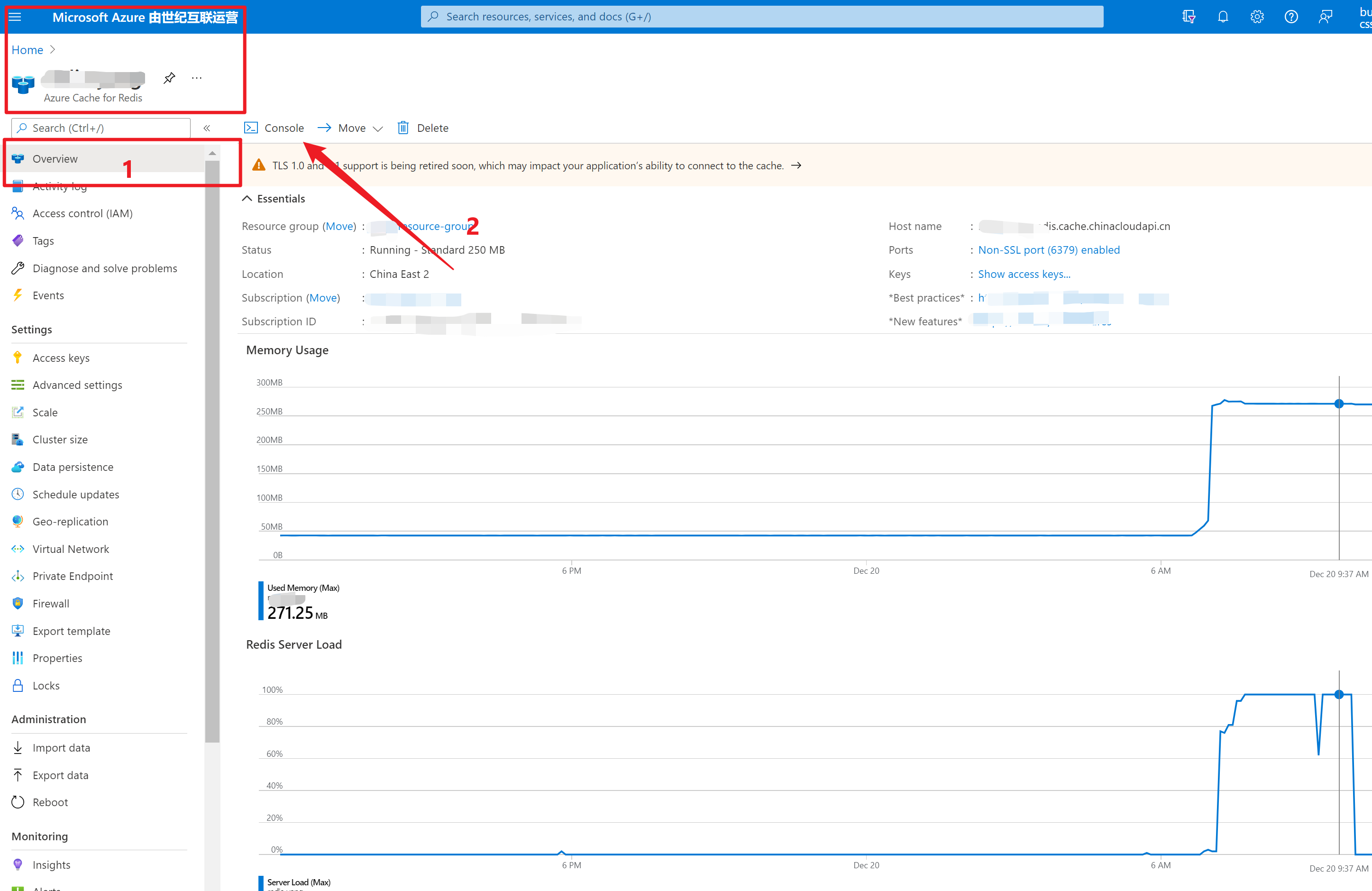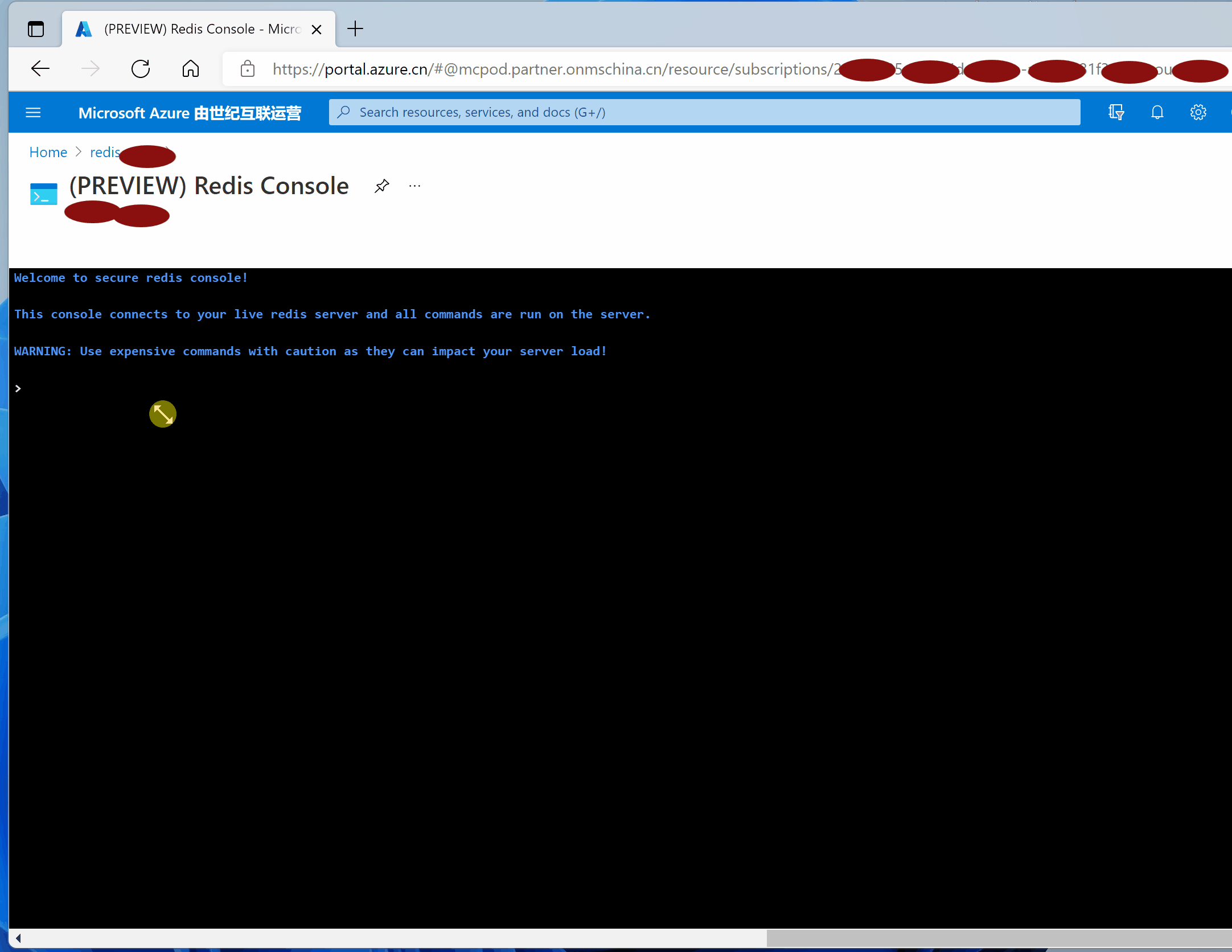【Azure Redis 缓存】Azure Cache for Redis 中如何快速查看慢指令情况(Slowlogs)
2021-12-20 20:26
1026 查看
问题描述
当 Azure Redis 服务器负载过高的情况下,使用时就会遇见连接超时,命令超时,IO Socket超时等异常。为了能定位是那些因素引起的,可以参考微软官方文档( 管理 Azure Cache for Redis 的服务器负载 : https://docs.azure.cn/zh-cn/azure-cache-for-redis/cache-best-practices-server-load#avoid-long-running-commands) 开始以下因素的分析:
- 值大小 : 可以通过Redis-cli.exe 的bigkeys来进行分析 [redis-benchmark -h <your redis name>.redis.cache.chinacloudapi.cn -a [xxxxxxxxxxxxxxxxxx your access key ] -t GET -n 1000000 -d 1024 -P 50 -c 50]
- 避免出现客户端连接高峰 : 可以查看Redis Metrics中的连接数
- 内存压力 : 通过查看Redis Metrics中的内存使用量
- 避免长时间运行的命令 : 通过Azure Redis门户上的console或者是Redis-cli.exe 来执行 slowlog get 100指令
本文就重点演示在Azure Redis门户上的console页面执行 slowlog get 100 指令。
问题回答
因为Redis 服务器是单线程系统。 长时间运行的命令(官名:慢指令, Slowlog)可能导致客户端出现延迟或超时,因为服务器在忙于处理长时间运行的命令时无法响应任何其他请求。那么,如何来查看慢指令呢?
第一步: 登录Azure门户,选择需要查看的Redis服务,进入Console页面

第二步:在Console命令页输入:slowlog g 1044 et 100

- slowlog get 100: 获取当前Redis服务中所记录的慢指令信息,每一个指令包含六部分内容,id,unix时间,指令执行时间(ms 微秒), 指令内容,客户端IP:端口,客户端机器名。
- slowlog len : 返回当前Redis服务器中所记录的慢指令日志中所记录指令数
- slowlog reset :清空当前慢指令记录
指令输出示例:
Welcome to secure redis console! This console connects to your live redis server and all commands are run on the server. WARNING: Use expensive commands with caution as they can impact your server load! >slowlog get 100 1) 1) (integer) 16 2) (integer) 1639993957 3) (integer) 10012 4) 1) "GET" 2) "key:__rand_int__" 5) "167.220.233.137:14835" 6) "" 2) 1) (integer) 15 2) (integer) 1639993727 3) (integer) 10195 4) 1) "GET" 2) "key:__rand_int__" 5) "167.220.233.137:19468" 6) "" 3) 1) (integer) 14 2) (integer) 1639992068 3) (integer) 13279 4) 1) "GET" 2) "key:__rand_int__" 5) "167.220.233.137:46504" 6) "" 4) 1) (integer) 13 2) (integer) 1639990412 3) (integer) 14152 4) 1) "GET" 2) "key:__rand_int__" 5) "167.220.233.137:39900" 6) "" 5) 1) (integer) 12 2) (integer) 1639990251 3) (integer) 10710 4) 1) "GET" 2) "key:__rand_int__" 5) "167.220.233.137:52381" 6) "" 6) 1) (integer) 11 2) (integer) 1639989209 3) (integer) 11665 4) 1) "GET" 2) "key:__rand_int__" 5) "167.220.233.137:38779" 6) "" 7) 1) (integer) 10 2) (integer) 1639989142 3) (integer) 13642 4) 1) "GET" 2) "key:__rand_int__" 5) "167.220.233.137:12348" 6) "" 8) 1) (integer) 9 2) (integer) 1639988822 3) (integer) 22073 4) 1) "GET" 2) "key:__rand_int__" 5) "167.220.233.137:51454" 6) "" 9) 1) (integer) 8 2) (integer) 1639988414 3) (integer) 13668 4) 1) "GET" 2) "key:__rand_int__" 5) "167.220.233.137:1550" 6) "" 10) 1) (integer) 7 2) (integer) 1639987239 3) (integer) 18846 4) 1) "GET" 2) "key:__rand_int__" 5) "167.220.233.137:57350" 6) "" 11) 1) (integer) 6 2) (integer) 1639986196 3) (integer) 12921 4) 1) "GET" 2) "key:__rand_int__" 5) "167.220.233.137:1739" 6) "" 12) 1) (integer) 5 2) (integer) 1639986196 3) (integer) 15833 4) 1) "GET" 2) "key:__rand_int__" 5) "167.220.233.137:1739" 6) "" 13) 1) (integer) 4 2) (integer) 1639985175 3) (integer) 14434 4) 1) "GET" 2) "key:__rand_int__" 5) "167.220.233.137:1649" 6) "" 14) 1) (integer) 3 2) (integer) 1639984227 3) (integer) 61332 4) 1) "GET" 2) "key:__rand_int__" 5) "167.220.233.137:24878" 6) "" 15) 1) (integer) 2 2) (integer) 1639984227 3) (integer) 27560 4) 1) "GET" 2) "key:__rand_int__" 5) "167.220.233.137:7637" 6) "" 16) 1) (integer) 1 2) (integer) 1639983695 3) (integer) 10361 4) 1) "SET" 2) "Message_dd2_0" 3) "eyJ0eXAiOiJKV1QiLCJub25jZSI6Inp1d2hMNzhSWDJsdGZITlN1TDYyOEhpRDNrTzhWSnJXZl9CNEtVcjBFTWsiLCJhbGciOiJSUzI1NiIsIng1dCI6IkpSNGxDdzkw... (4140520 more bytes)" 5) "167.220.233.137:1166" 6) "MININT-S4MGVOU" 17) 1) (integer) 0 2) (integer) 1639983310 3) (integer) 16577 4) 1) "SET" 2) "Message_dd_2222" 1044 3) "eyJ0eXAiOiJKV1QiLCJub25jZSI6Inp1d2hMNzhSWDJsdGZITlN1TDYyOEhpRDNrTzhWSnJXZl9CNEtVcjBFTWsiLCJhbGciOiJSUzI1NiIsIng1dCI6IkpSNGxDdzkw... (7774 more bytes)" 5) "167.220.233.137:58313" 6) "MININT-S4MGVOU" >slowlog len (integer) 17 >slowlog reset OK >slowlog len (integer) 0
Each entry from the slow log is comprised of the following six values:
- A unique progressive identifier for every slow log entry.
- The unix timestamp at which the logged command was processed.
- The amount of time needed for its execution, in microseconds.
- The array composing the arguments of the command.
- Client IP address and port.
- Client name if set via the CLIENT SETNAME command.
参考资料
SLOWLOG GET [count]:https://redis.io/commands/slowlog-get
管理 Azure Cache for Redis 的服务器负载: https://docs.azure.cn/zh-cn/azure-cache-for-redis/cache-best-practices-server-load#value-sizes
相关文章推荐
- 【Azure Redis 缓存】使用Azure Redis服务时候,如突然遇见异常,遇见命令Timeout performing SET xxxxxx等情况,如何第一时间查看是否有Failover存在呢?
- 【Azure Redis 缓存 Azure Cache For Redis】使用Redis自带redis-benchmark.exe命令测试Azure Redis的性能
- 【Azure Redis 缓存 Azure Cache For Redis】Redis连接池
- 【Azure Redis 缓存】Azure Cache for Redis 是否记录具体读/写(Get/Set)或删除(Del)了哪些key呢?
- 【Azure Redis 缓存 Azure Cache For Redis】Redis支持的版本及不同版本迁移风险
- 【Azure Redis 缓存 Azure Cache For Redis】Azure Cache for Redis有默认备份可以用于恢复么?
- 【Azure Redis 缓存】Azure Cache for Redis 专用终结点, 虚拟网络, 公网访问链路
- 【Azure Redis 缓存 Azure Cache For Redis】Azure Redis删除 TLS 1.0 和 1.1的计划及问题
- Azure Redis Cache作为ASP.NET 缓存输出提供程序
- 【Azure Redis 缓存】如何得知Azure Redis服务有更新行为?
- 如何使用 @ OutputCache 指令的 VaryByCustom 属性来缓存不同版本的页面
- 如何查看redis内存使用情况
- 利用Azure Redis Cache构建百万量级缓存读写
- 如何将 Azure Redis 缓存与 Java 配合使用
- 如何查看redis内存情况
- 如何使用 @ OutputCache 指令的 VaryByCustom 属性来缓存不同版本的页面(二)
- 如何使用 @ OutputCache 指令的 VaryByCustom 属性来缓存不同版本的页面
- 【Azure Redis 缓存】Azure Reids是否可以开启慢日志(slowlog)和执行config指令
- 【Azure Redis 缓存】Redis的指标显示CPU为70%,而Service Load却达到了100%。这两个指标意义的解释及如何缓解呢?
- 如何查看redis内存使用情况
